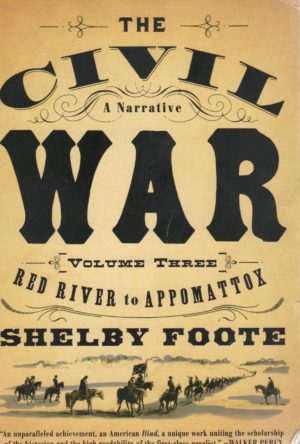
When my pal Dave Michelson handed me Foote’s ginormous three volume study of America’s War Between the States, I was daunted by the task of reading 2,846 pages of history. History that at least, in part, I was aware of. But, as in all things that Dave has suggested over the fifty years of our friendship, I acquiesced and dug in. That was last summer, before Dave, his wife Lail, and six other couples joined René and I for a two-week cruise in the Mediterranean. Well, here we are in May and I finally finished the read! To the review.
Throughout the three volumes of this study, Foote makes his southern upbringing and outlook clear despite his attempts to conceal it. He reveals, though he tries not too, a personal affinity for the Confederacy and the right of secession. No that he applauds slavery and all of its ills. He acknowledges the institution’s evils and makes it clear that slavery, upon which the entirety of the Southern agrarian economy was based, had to go. But he spends much time inside the politics of Jeff Davis and his confederates (pun intended) trying to explain how the South didn’t begin the conflict in a vacuum, how Lincoln’s election triggered secession. That, of course, is indeed true. But Lincoln’s fairly modest anti-slavery stances before Ft. Sumter were, in my humble opinion, an excuse used by the radicals in the South to attempt the unthinkable; the dismemberment of the American experiment. And though Foote paints a fairly accurate and sympathetic portrait of Lincoln as a man and leader, his dissection of Davis’s and the South’s political motivations for firing the first shot ring hollow against the one and fundamental truth: Slavery, the mass bondage of an entire population of Africans brought here against their will, was and is a sin. A sin against man. A sin against God. Many times, as the author digressed into long-winded dissertations about the politics of the Confederacy, I simply skimmed over sections to get to the action.
That’s where Foote really shines. His depiction of the military leaders on both sides of the conflict, the details of their personalities and attributes and upbringings, when placed in the context of Bull Run and Shilo and Vicksburg and Gettysburg and the fall of Atlanta and all the rest is the reason to read this series. Foote is a master of describing skirmishes and battles, including much about Texas and the Wester Front left out in slimmer versions of the war’s history, and making it clear to the reader what transpired. The horrors. The casualties. The losses of loved ones. The genius of Lee and the steadfastness of Grant when finally, Lincoln makes him the overall commander of the Union forces. The dogged determination so men like Sherman and Sheridan and Forrest and Johnston to see their missions through. It’s all here in concise and precise detail.
His portrait of Lincoln’s last months as president, Lincoln’s travels to Richmond after the Army of Northern Virginia (Lee’s army) is dispatched, and the greatest president’s final days is all supremely wrought. His depiction of Jeff Davis’s attempted escape, incarceration, and ultimate release is equally well done. The last two hundred pages of the series was worth the slog that sometimes accompanied the earlier political digressions and personal stories, all of which added color to the page but didn’t necessarily move the narrative forward.
Foote’s work here is laudatory despite the Southern winds whistling through its pages. It’s one of those rare histories written, not by the winners, but by a descendent of the losing side. It is worthy, despite its attitude and somewhat biased bent, of reading by anyone interested in the possible disintegration of our Republic.
Thanks, Dave, for getting me to read this!
Volume 3 is the best of the lot: 5 stars. As an overall review, I’d give the three-book set a rating of 4 and 1/2 stars.
Peace.
Mark


